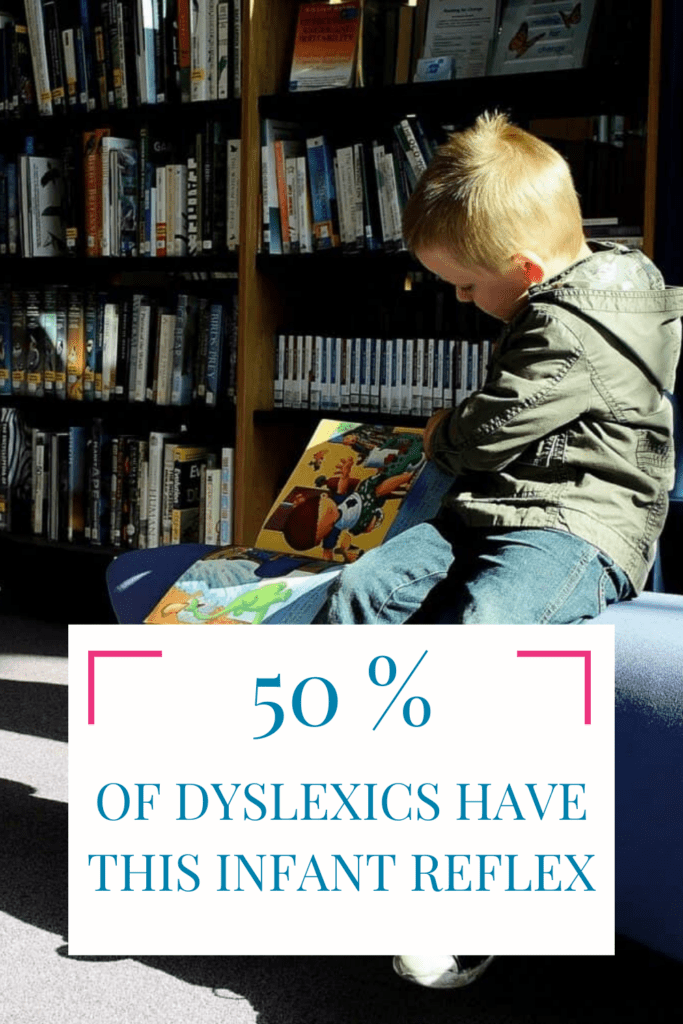You know what drives me bananas about how we address reading struggles? We have kids read more to try and fix it. We think that the problem and cause of reading struggles are related to reading itself.
I am here to tell you – they are not. Reading struggles don’t even start with things like poor phonemic awareness or letter reversals. Those are the symptoms.
Reading difficulties are a symptom of a breakdown or disconnect that is occurring in the lower brain levels and likely originated in early development.
The actual root cause that is causing reading and writing breakdown are things like poor communication between the two brain hemispheres, poor balance, hand-eye coordination, eye-tracking as well as auditory processing skills.
50% of Dyslexics Still Have This Infant Reflex
There are many reasons why these areas may be weak or underdeveloped, but one of the first places I look when there are reading difficulties is a retained Asymmetrical Tonic Neck Reflex (ATNR).
50% of dyslexics have been found to have a retained ATNR reflex. This reflex develops at 18 weeks post conception and should integrate or disappear at around 6 months.
Like all primitive reflexes, the ATNR is an involuntary response, in which an infant turns their head to one side due to visual, tactile or auditory stimulation and the leg and arm on that same side will straighten, while the leg and arm on the other side of the body will bend.
The result of this involuntary head turn and limb movement in reaction to stimuli is that different pathways and processes become more ‘fine-tuned’.
The auditory and visual pathways become more acute and begin to tune into foreground information and tune out background stimuli.
These reflexes serve several purposes:
1. Birthing process
Inhibits limb movement so that the bay can descend the birth canal in a corkscrew manner.
2. Survival
The ATNR prevents airway obstruction when a baby is lying on their belly because the reflex triggers a baby to turn their head to the side.
3. Vision Development
The ATNR assists with hand-eye control and this connection assists with depth perception as well as eye-tracking which crosses the midline. When a child turns their head, they reach and touch an object which is how near vision begins to be developed. As this develops and a child starts to crawl, this allows a child to develop far vision.
4. Muscle Tone & Movement
This reflex stimulates homolateral as well as cross-lateral movements that are seen in early infancy such as rolling, creeping and crawling. These movements help to develop muscle tone which is key to cognitive function and this movement also helps to develop the vestibular system.
5. Development of Left and Right Brain Communication
Before the ATNR integrates, it helps to develop the bundle of nerves between the left and right brain hemispheres called the corpus callosum. The left and right brain hemisphere have very specialized roles and this band of nerves between these two hemispheres are known as the brain’s information superhighway.
6. Development of Auditory Processing
This reflex both in utero as well as in infancy develops auditory processing which is important not only for hearing but for such processes as phonemic awareness. As a baby learns to crawl with the assistance of such reflexes as the ATNR, the cross-lateral movement and the turn of a baby’s head to various sounds stimulates and trains both brain hemispheres to work together and develops their auditory skills.
How Breakdown with Reading & Writing Can Occur
If this reflex fails to integrate into the nervous system at around 6-7 months, then the reflex is retained. This means the processes that were supposed to occur didn’t develop fully or properly.
This involuntary response which should assist with brain development and disappear now gets in the way and prevents a child from optimally using their cortex and being able to efficiently learn, read, write and/or speak.
A Retained ATNR Leads to an Immature Brain
A retained ATNR hinders mature development of the brain and body. Accurate fine and gross motor skills and right and left brain integration are necessary for optimal learning and movement.
Difficulty crossing the midline, poor coordination, eye tracking and hand-eye coordination will all result in varying degrees of breakdown with reading and writing skills depending on how severely the ATNR Reflex is retained.
Problems with Crossing the Midline
A child may have difficulty crossing the midline because there is poor left and right brain communication. This can look like difficulty differentiating the right and left side of the body, difficulty getting the eyes to cross the midline or challenges with turning their head while walking, writing or reading.
It is for this reason why children with learning disabilities may need accommodations to copy notes from the board. As they write, their eyes will want to turn in the direction of their hand rather than the notes they need to see in order to copy.
Is a Retained ATNR Behind Your Child’s Diagnoses?
Auditory processing and eye-tracking are necessary for good reading, writing or possibly even sports. This can result in a child being diagnosed with dyslexia, learning disabilities, visual processing disorder, dysgraphia and even dsypraxia.
Writing problems frequently arise with a retained ATNR since it can trigger involuntary extensions of the hand when the head turns in the same direction of the hand. This can result in challenges for a child to have a good grip on their pen or pencil. The child may use excessive pressure when writing and have illegible handwriting.
Signs of a Retained Asymmetrical Tonic Neck Reflex:
- Poor hand-eye coordination
- Reading or writing difficulties
- Difficulty crossing the mid-line.
- Diagnosis of dyslexia or a reading disorder
- Reverses letters like ‘b’ and ‘d’, ‘p’ and ‘q’
- Poor gross motor coordination and balance.
- Visual processing difficulties. Easily loses their place when reading.
- Illegible handwriting, tight pencil grip
- Speech and language difficulties
- Difficulty catching a ball
- Mixed dominance, difficulty telling left from right
- Poor short term memory and difficulty following verbal instructions.
- Impulsive and emotionally immature for their age
- Awkward gait or walk
- Poor focus and listening skills
- Jerky eye movements
Learn more about how primitive reflexes like Moro reflex as well as how to test to see if it is still present by registering for my free webclass where you can learn the three simple secrets I use to help kids reach their full potential in school and at home?
In This Free Web Class, You’ll Discover:
- How to move past band-aid solutions so your child can learn, focus and be a calmer happier kid and you can have peace of mind.
- A simple way to get your child learning at grade level and being able to manage their behaviour, without having to do hours of homework, tutoring or doing restrictive diets.
- The secret sauce to your child becoming a star student and a happier, calmer kid
- Did you know once the brain is bio-chemically balanced and weak and underdeveloped connections are strengthened then your child doesn’t need to rely on ongoing tutoring or IEP medications? This means your child can overcome their challenges with learning and behaviour without hours or years of tutoring or even relying solely on medication.
- Plus a whole lot more…
Sign up here.
In Health & Wholeness,
Lorraine
Sources:
Bonnie Brandes – ‘Symphony of Reflexes’
Dr. Harald Blomberg – ‘The Rhythmic Movement Method’
https://www.ncbi.nlm.nih.gov/pmc/articles/PMC3923298/


